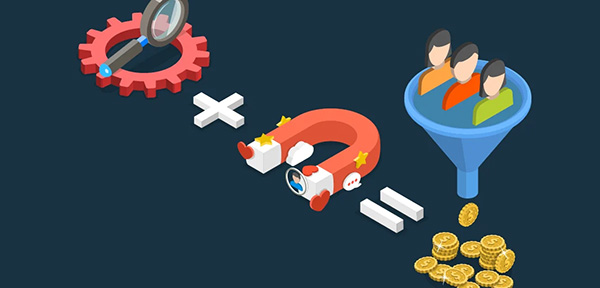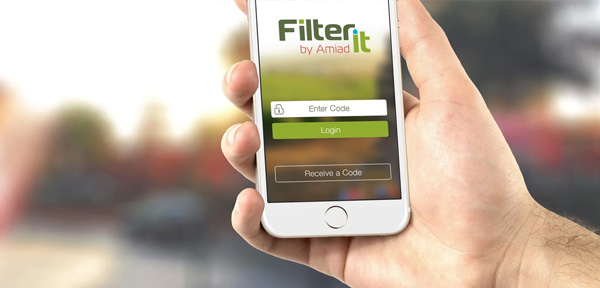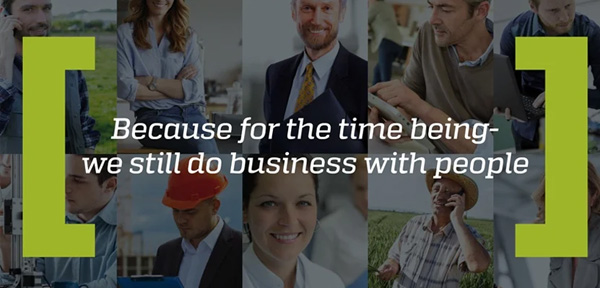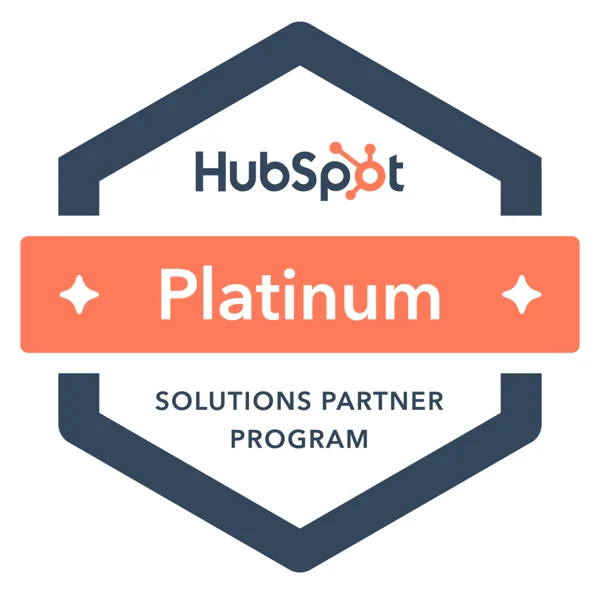The BL[OZ]
HUG Haifa – SALES & MARKETING ALIGNMENT
By
Jonathan Cohen
, 08/08/2019
The HUG Haifa debut was a triumph. We gained insights from HubSpot's Stephen Fuery and BERMAD's Ofir Marx, which will advance our Marketing and Sales projects.
- 87% Of the terms sales & marketing use to describe each other are negative
- 20% - The amount of revenue increase companies with strong sales & marketing are able to achieve.
- I don’t know if the sales team is working my leads
- I don’t know the ROI of my marketing campaigns
- I’m getting too many leads and can’t prioritize them
- I don’t know what to do with these Marketing leads.
Service Level Agreement (SLA)
This is a commitment between Marketing & Sales to deliver on specific goals. How do you create an SLA? Glad you asked 😊. Use Historical data to understand your goals, putting into consideration the common goals between the two teams. Ask yourself these questions as a roadmap to creating an SLA that serves both the marketing and sales teams:- How many MQL’s is Marketing creating?
- Are Sales working MQL’s?
- At what rate are MQL’s converting to Customers?
- What % of deals are attributed to Marketing?
Decide on future SLA’s and build reports to measure them, presenting SMART (Specific, Measurable, Actionable, Relevant, Timely) goals.
Let’s compare: Goal 1: I want more website visitors, leads and sales. But this is too general, what about? Goal 2: I need 20,000 visitors, 500 leads, 12 customers within 12 months in order to achieve our revenue goal of $600,000 from Inbound. Goal 2 is a SMART goal. It will give you a complete picture of what you want to achieve.Agree on Fit
This is a measurement of how well you could serve a lead if they were to become a customer.Segmentation:
Let’s divide segmentation into two parts:- Lifecycle stage: a way of categorizing where any given contact or company is within your marketing and sales flywheel.
- Lead Scoring: Lead scoring is a methodology used by sales and marketing to determine the worthiness of leads or potential customers by attaching values to them based on performance.
- Publishing professional blogs, case studies, and white papers
- Sending out nurturing emails to leads
- Posting on social media
- Using marketing automation to convert a lead to SQL
- Increase involvement in LinkedIn discussion groups
- Target campaigns in specific locations
- Blog in other languages
- Introduce Account Based Marketing activities.
Can Inbound Marketing Really Impact on Your Bottom Line?
By
Orit Oz
, 08/03/2019
Bermad, a kibbutz-based company manufacturing water control valves, built itself into a successful global concern from the ground up.
The conversation has changed: From top down to two-way communication
“Today, we can communicate directly with customers,” says Marx. “In the past, our way of communicating with customers was top down. HQ communicated to its subsidiaries, who communicated to the dealers, who in turn, communicated to the end users. We never got direct feedback, and even if we did, it had passed through three to four different hands and got filtered along the way. That’s changed. Now by publishing blogs, case studies, and white papers, sending out emails, and posting to social media, we have the ability to deliver messages directly to the end user and get feedback.“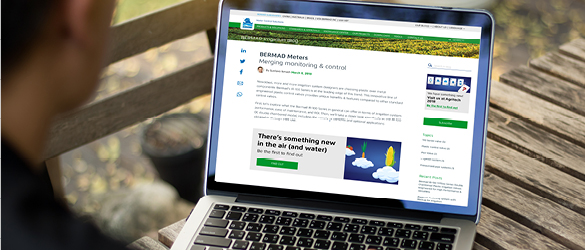
Generating leads, assessing quality
Leads are collected on landing pages with targeted calls to action (CTAs). By asking qualifying questions, Bermad is able to assess the quality of the leads received. The results show that 35% are sales qualified leads (SQL), 30% are marketing qualified leads (MQL), and the balance are service requests, spare parts or vendors looking to sell the company something. In short: More than 60% leads are relevant enquiries.Key goals versus results
At the beginning of the process, Bermad set some goals:- Increase site traffic to 20,000 Moved from 12,000 to 20,000 website visitors per month in less than 2 years
- Generate 500 leads per month Approximately 200 leads per month now and it’s rising
- Added Revenue of $1,000,000 per year Reached $700,000 in 2017; anticipate higher in 2018
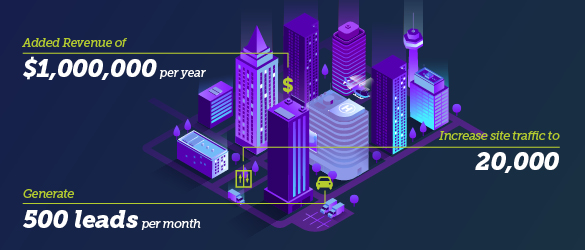
Are we getting it right?
The ability to speak directly to the marketplace and understand what they are interested in and what questions they ask, enables the company to understand whether they need to do anything differently.What’s next?
Marx believes that the awareness and exposure that is being gained is very important, and it’s only the beginning. There’s still much to be done, from increased involvement in Linked In discussion groups to targeted campaigns in specific locations, as well as blogging in other languages such as Spanish and Portuguese.Leveraging the power of marketing automation
The company is just beginning to benefit from the powerful marketing tools available on HubSpot including lead scoring and nurturing. Having tripled the amount of contacts, there is a wealth of potential customers to cultivate, taking them from the awareness and consideration stages through to making the decision to purchase.It takes time, effort and investment
Today, all Bermad’s divisions are involved, with 4-5 people at HQ contributing to content creation as well as support from professionals at the company’s various subsidiaries. Blogs are published on a monthly basis for all four segments (waterworks, irrigation, fire protection and building & construction), supported by email blasts, newsletters and ongoing social media posts. Campaigns are run to support product launches, exhibitions and special events. All marketing activities are integrated into Bermad’s CRM system, allowing the sales team to see a 360° view of potential customers and enabling them to close more deals. “Today, nobody asks why we are doing it,” notes Marx. “We’re just beginning to see the benefits.”Getting creative in B2B marketing
By
Miri Peled
, 15/05/2017
Yes, branding is vital to success. But what about lead generation, which is also crucial to business and requires creative methods to bring in qualified leads?
What’s all the fuss about Inbound marketing?
By
Orit Oz
, 15/05/2017
We’ve all heard the term Inbound marketing thrown around a lot lately. It’s become the latest catchphrase in a field that’s already packed with catchphrases.
What is Inbound marketing?
Inbound marketing is the process of attracting potential customers and getting them to reach out to you. This is different to more traditional marketing (also known as push marketing or outbound marketing) where you actively reach out to potential customers through methods such as cold-calling, printed magazines, and traditional advertising. But how do you attract potential customers and get them to trust you before you’ve even pitched them your product? The answer lies in content —the foundation of the Inbound methodology. By creating carefully curated content, you’ll establish yourself as a trusted source of knowledge and attract the ideal visitors to your site, convert them into leads and then customers, and keep them engaged so they go on to promote your brand. “By publishing the right content in the right place at the right time, your marketing becomes relevant and helpful to your customers, not interruptive.” - Hubspot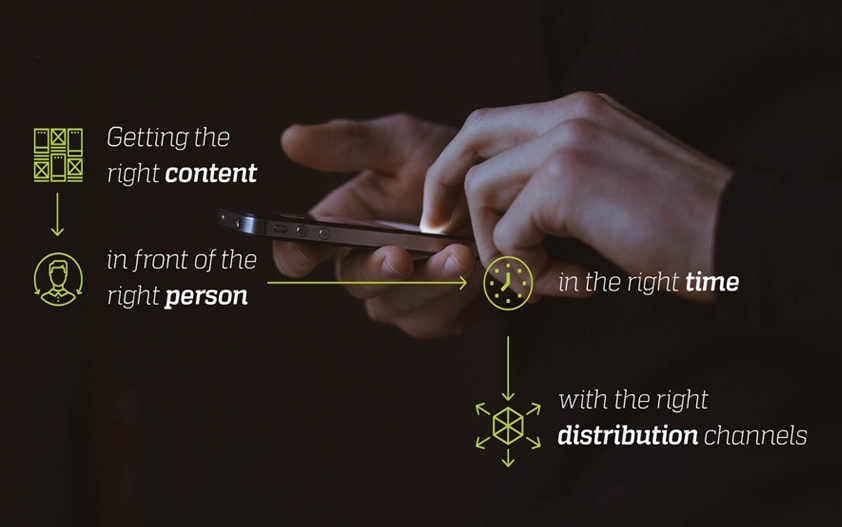
Inbound marketing in a nutshell
Inbound marketing is filled with complexities, but the following four steps (based on the Hubspot Inbound methodology) summarize the main Inbound stages:- Attract. Before you do anything, you need to fully research and understand who your ideal customers or buyer personas are. Once you have identified them, you can get them to come to you.
- Find creative ways to “convert” these potential customers into leads by offering them something valuable in return.
- Turn your leads into customers.
- Continue to engage with your customers so they become promoters of your brand.
Inbound marketing in B2B
At this stage, you may be wondering whether Inbound marketing works in the world of B2B. The answer is a big loud “Yes!” In fact, Inbound marketing creates a win-win situation for you where you can get closer to your direct customers and distributors, and also increase brand awareness amongst end users to enhance end-user demand for your brand (even if you they are not buying directly from you). Read how Elcam used digital marketing to increase brand awareness>>Combining Inbound and offline marketing
We’d like to emphasize that Inbound marketing does not replace the need for interpersonal interaction with your customers – especially in B2B industries where the customer model tends to be more complex and is often based on long-term relationships. The goal is to find the right communication mix for your specific B2B business needs, market and customers. By promoting your brand through a digital dialog and an inter-personal dialog, you can achieve a more effective and efficient sales and marketing process for better business results. For example, you can combine a compelling digital campaign to encourage potential customers to visit you at a trade show, and then meet them at the event to continue a direct dialogue with them. Look out for our next blog post on the need for face-to-face communication with your customers and creative ways to combine digital and interpersonal communication (coming soon).Inbound marketing – here to stay?
Another big loud “Yes!” It’s quite simple - as more and more potential buyers turn to the Internet for answers to their challenges, they look to buy from suppliers who instill trust by answering their questions and offering solutions to their problems. This means that in order to stay relevant in the marketplace, you have to be present where your potential buyers are looking for answers - online. And that’s why everyone is fussing over Inbound marketing.The importance of branding in launching new products
By
Orit Oz
, 15/05/2017
Prior to the recent release of Mazor X, Oz Branding worked with Mazor Robotics to create a compelling brand promise for the new product — Align with Experience.
The changing role of CMOs in B2B marketing
By
Miri Peled
, 15/05/2017
Customer empowerment has led to a changing CMO role as CMOs become the customer voice within their organizations. But what does this role actually involve?
The customer leads the way
With digital disruption and an ongoing increase in Internet and social media usage, consumers now have almost all the information they need at their fingertips. In fact, research shows that the majority of customers engage in online research and brand comparison before they commit to a specific product or service — even (and often especially) in the world of business to business (B2B) — and continue to use online platforms at multiple points across their buyer journey. This has far reaching effects on the marketplace, and businesses are being forced to adapt their marketing strategy accordingly. Instead of interruptive marketing fighting for a customer's attention and money, twenty-first century businesses need to focus on both offline and online marketing to attract potential customers, increase sales and maintain an ongoing relationship with their customers.Expanding the CMO’s Role
These changes to customer behavior, as well as the ability of companies to reach a more diverse and global customer base, have led to an expansion or even a complete redefinition of the CMO’s role, in both B2C and B2B marketing. As advocators for customers — or the “voice of the customer” —CMOs will need to lead changes across companies. This involves playing a more active role in areas such as global branding strategy and public profile, product development, leading the move from a product-centric to a customer-centric model, content planning and generation, digital media, and more.Using online marketing to generate a buzz (or a moo)
By
Miri Peled
, 15/05/2017
When Afimilk was preparing to launch its new AfiLab, the company turned to Oz Branding for assistance in creating a combined online and offline campaign.
Afimilk case study: all you need is lab
When Afimilk — a pioneer and global leader of management technology for dairy farming — was preparing to launch its In-line Milk Lab internationally, the company turned to Oz for assistance in creating a combined online and offline campaign for the launch.- Online – including digital ads in a variety of professional magazines, a social network campaign that was launched 6 weeks before the expo, the creation of a specific AfiLab mini-site, blog posts on the subject, a newsletter, a PR, and more.
- Offline – including brochures, a booth at the trade show, giveaways, printed ads, and more.
The Online Approach to Event Marketing
By
Miri Peled
, 14/05/2017
This post will explain how to effectively integrate the two to achieve your company's greater marketing goals when it comes to marketing a conference
1. The More Targeted the Event, the Better
At an industry conference, you want your booth and company to really stand out among the others. The larger the conference and broader the topic, the more challenging it will be for your product to grab the attention of potential customers. One of our customers, Elcam Medical, for instance, started to see fantastic results after attending more targeted events. After undergoing a branding process which sought to position the company as experts in ensuring safety in the hospital environment, they understood that they were marketing not only to their supplier, but also to their end user -- ICU nurses. You can read more about Elcam's success in integrating online and offline marketing strategies here>> As a result, instead of attending the usual larger medical conferences and trade shows, they began to attend more targeted professional conferences of nurses, albeit with a smaller booth. Since the subject was so targeted, Elcam Medical was often able to generate awareness of their product by speaking on the lecture panel at the conference.2. Be Really Clear About Your Inbound Goals
Make sure everyone in your marketing department is working together towards the same goals. Your inbound marketing activity before, during, and after events can support your greater marketing strategy of lead generation by:- Increasing both direct and indirect traffic to your company website
- Increasing the number of email or blog subscribers
- Educating potential customers about your specific product or service
- Increase the number of requests for a product demo
3. Identify your Call-to-Action (CTA)
A call-to-action, or CTA, is an action which you want potential customers to take. This is the method by which you achieve your goal, which you've properly defined in #2. Your CTA could be to convince potential customers to register for the event, download your ebook or white paper, sign up for your webinar, take a survey, or just visit your latest product or service page. By convincing potential customers to take this action, you are driving them further along the sales cycle. Other parts of your company can benefit from trade shows as well, so it is important to sit down and brainstorm with management in different departments to get their input. One of our clients, Afimilk, decided that in order to promote their new product, the AfiAct II at the World Dairy Expo, they would run a lottery during the event to give away the product to one lucky registrant for free. We integrated a CTA into all of their marketing materials for this event, adding it to the Afimilk website homepage, and creating landing page dedicated to registrations specifically for the event.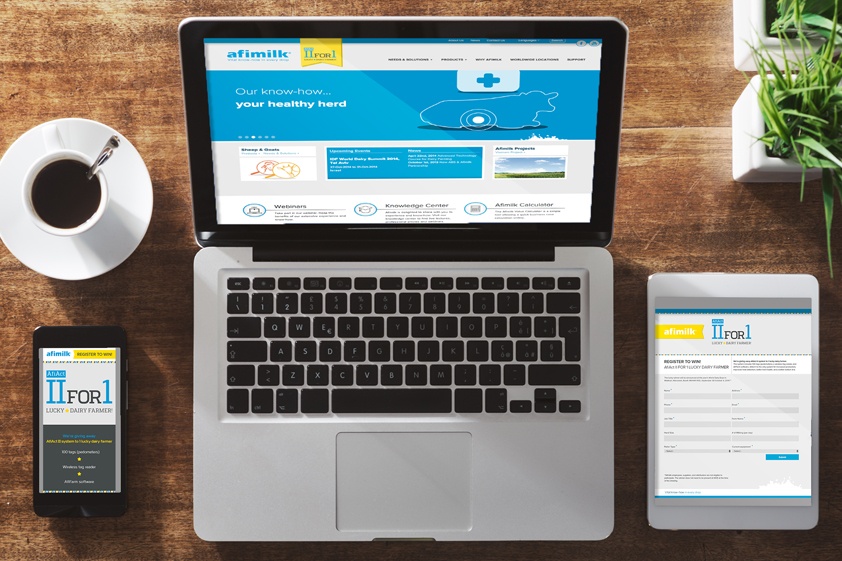
4. Create a Dedicated Landing Page to Promote your Event
The best landing pages promote events before and after the event. How? Before the event, they help to schedule appointments with your sales and marketing team, explain exactly what your company will be doing at the event, and promote a particular product or service. After the event, they publish reactions and insights from the event as well as the speaker's presentations on the landing page. Another purpose of your dedicated landing page before the event can be to get specific info from potential customers in order for your sales team to qualify them. But in an environment where you are competing with many other companies for the attention of the same people, you'll need to stand out from the crowd. Why would they want to give you information about themselves? You'll have to offer them something in return. Think really hard about what your potential customer's pain point is and how you can help them – for free, in exchange for their contact information. Here's an example from one of our customers, Plastopil, where we inspired customers to register to an event by offering them a free iPad mini: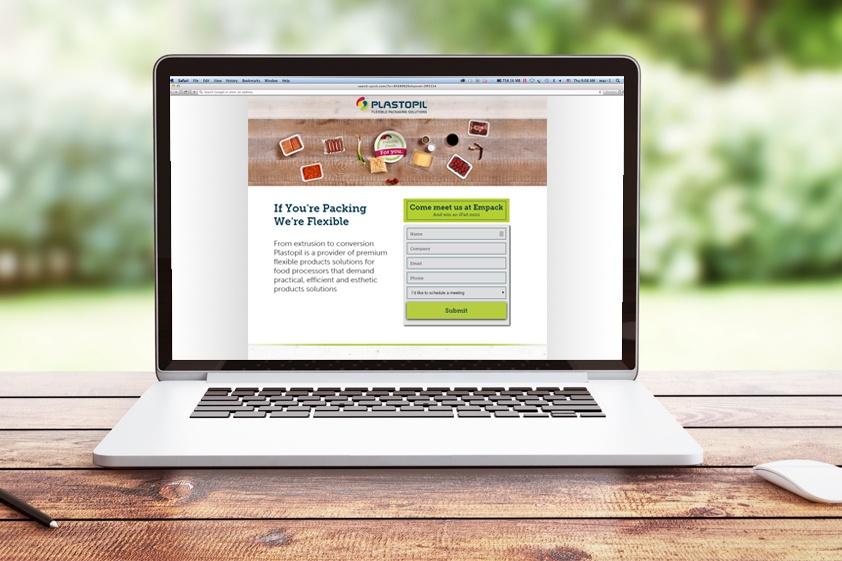
5. Promote Your Event via Email Marketing
Invite your contacts to the event with an email beforehand, sending them to your dedicated landing page in order to register for the event or schedule appointments, educating them about your services and products, or offering them a free ebook or white paper to show them you understand (and have a solution to) their main pain point. You may want to send an email promoting the event several times beforehand – perhaps a month, two weeks, and then the week of the event.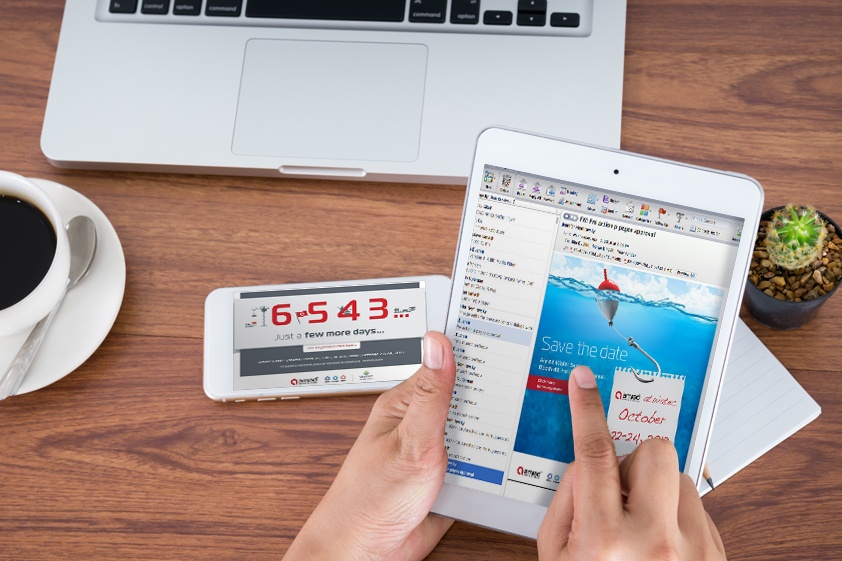 Follow up afterwards with either a thank you or a newsletter that recalls the event. If you blogged about the event, include those posts in the newsletter as well.
Follow up afterwards with either a thank you or a newsletter that recalls the event. If you blogged about the event, include those posts in the newsletter as well.
6. Combining Online and Offline for Maximum Results
A major goal in B2B conferences is to build new business relationships and strengthen old ones, both of which are key in lead generation. This offline approach should not be underestimated. However, you can use inbound marketing to gain the attention of new potential business partners, educate them about your products and services, and have that first meeting be as effective as possible.Should I Still Speak to My Customers Face-to-Face?
By
Miri Peled
, 14/05/2017
Are you struggling to find the right marketing mix? Get some tips on creating an offline marketing strategy that is complemented by your online strategy
Integrating online and offline marketing
With all of this focus on online marketing, we tend to think that we should invest all of our energy in our online presence. But it’s not that simple as customers don’t only spend their time online. While online marketing is crucial to growth and success, you need to also engage your customers using offline methods – especially in B2B industries where long-term relationships with customers are crucial to success. A good way to understand this is to compare it to the use of social media in our personal lives. Most of us frequently share personal information about ourselves, our families, our hobbies, and more, on social media platforms. Despite the fact that these platforms seem to “replace” direct relationships, that’s not usually the case, and most of us still make a lot of effort to meet with our families and friends on a regular basis to nurture our inter-personal relationships. If we apply this example to business, we can build well-balanced marketing strategies by combining the use of social platforms to share knowledge with potential customers and build their trust, with inter-personal, offline interactions.
Not mutually exclusive
Using both online and offline marketing doesn’t mean that you need to create separate strategies for each. Instead, you need to create the right marketing mix for your company and field where your offline marketing strategy is actually complemented by your online strategy, and vice versa. Here are some examples:1. Trade shows
Trade shows may be traditionally associated with “offline” marketing, but you can leverage your investment in them by using a digital strategy to promote your company’s presence at the event. This can be done through digital ads, social media campaigns, landing pages, calls-to-action, and even webinars or videos talking about the upcoming event and where to find you. These promotions can be used to both promote your business in general, and to set up meetings or collect quality leads.At the event, you’ll be able to meet these potential customers (and other) face-to-face and most importantly, to follow up after the event based on what they told you about their specific needs. Again, the follow-up communication can be done through both direct communication and digital communication such as newsletters.
Read here about the online approach to event marketing>>
2. Samples to customer
Offer potential buyers and distributors that leave their contact details via digital platforms free samples of your products (where relevant) or promotions. In this manner, you can collect quality leads from customers, communicate with them directly to get them to try your products, and continue to engage with them through online campaigns. You can also use geo-driven campaigns to attract potential buyers and then refer them to local points-of-sale.
3. Digital campaigns and demos
Use digital campaigns and landing pages to encourage potential buyers to leave their information and then call them to set up a live demo of your product. You can continue to nurture the relationship with these potential buyers after the demo through a combination of offline and online marketing techniques.
4. Join social media groups
Join and contribute to social media groups in your field, use them to increase your brand awareness, and look out for offline networking initiated by these groups, including impromptu meet-ups and offline conversations. You can also initiate such offline events in order to meet potential leads face-to-face.
The best of both worlds
So the answer is yes – you should DEFINITELY still speak to your customers face-to-face, and communicate with them in every way possible to secure and nurture long-term trust and relationships, and meet their specific goals and needs. To get the most out this combined approach, make sure your brand promise, messaging, and visual language is consistent across all platforms so that your potential buyers and promoters recognize you wherever you are.Creating an Exceptional Digital Experience for Millennial Buyers
By
Miri Peled
, 14/05/2017
Exceptional Digital Experience. millennial buyers have the first digital contact and are determining which vendors should even be considered by the C-suite.
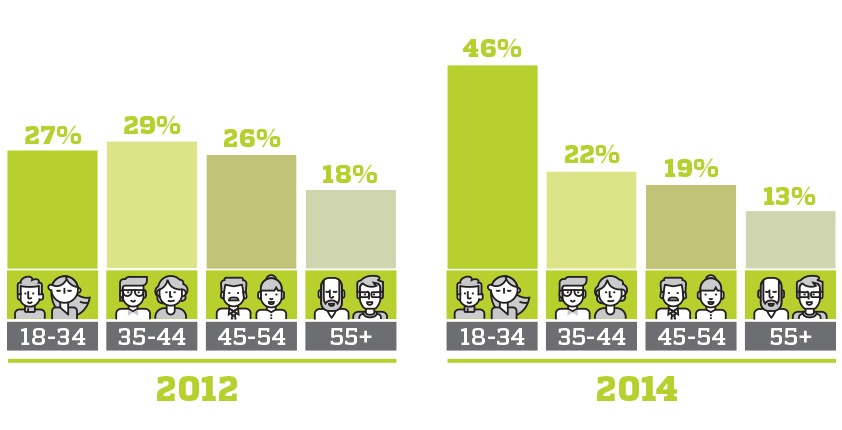 Image by Google/Millward Brown Digital, B2B Path to Purchase Study, 2014
According to an IBM study, millennials value a hands-on, authentic experience with a brand. The challenge for B2B organizations, therefore, is creating a relevant, seamless digital experience that millennials can connect to – at the right time and in the right digital channel.
That's why an exceptional digital experience for all of your customers, including millennials, is so crucial. Since a CEB study found that buyers are now as much as 57% of the way through the buying process before actually engaging with a seller, you need to create a lasting impression that will raise your vendor to the top of the list.
Image by Google/Millward Brown Digital, B2B Path to Purchase Study, 2014
According to an IBM study, millennials value a hands-on, authentic experience with a brand. The challenge for B2B organizations, therefore, is creating a relevant, seamless digital experience that millennials can connect to – at the right time and in the right digital channel.
That's why an exceptional digital experience for all of your customers, including millennials, is so crucial. Since a CEB study found that buyers are now as much as 57% of the way through the buying process before actually engaging with a seller, you need to create a lasting impression that will raise your vendor to the top of the list.
How can your B2B organization transform itself into a digitally mature organization and leave a lasting impression on millennial buyers?
This post will offer three suggestions for creating an exceptional digital experience.Focus on the Customer Experience
Remember what we mentioned above about creating a relevant and seamless digital experience? You'll need to examine your customer's priorities to provide content that focuses on them and their needs. For B2B organizations, this means not only prioritizing strategic concerns such as customer experience, but also growing revenues and reducing costs. It also means making tactical decisions to improve the digital experience (see the graph below).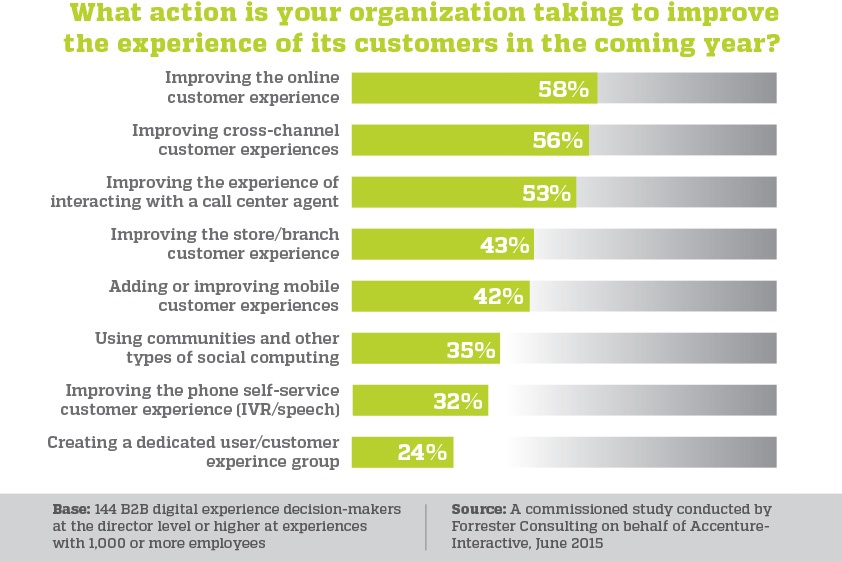 Digital and customer experience for B2B companies are becoming synonymous, and that's why an engaging and relevant digital strategy focuses on the customer.
Digital and customer experience for B2B companies are becoming synonymous, and that's why an engaging and relevant digital strategy focuses on the customer.
Assign the C-Suite Responsibility for Digital Strategy
In order to execute the digital strategy effectively, you'll need guidance from someone who's been assigned responsibility for the digital strategy.In some companies it's the CEO, in others it's a Chief Information Officer (CIO) or chief digital officer. Whatever the title, someone in the C-Suite must lead the company with their end vision, with any changes being a result of this end vision.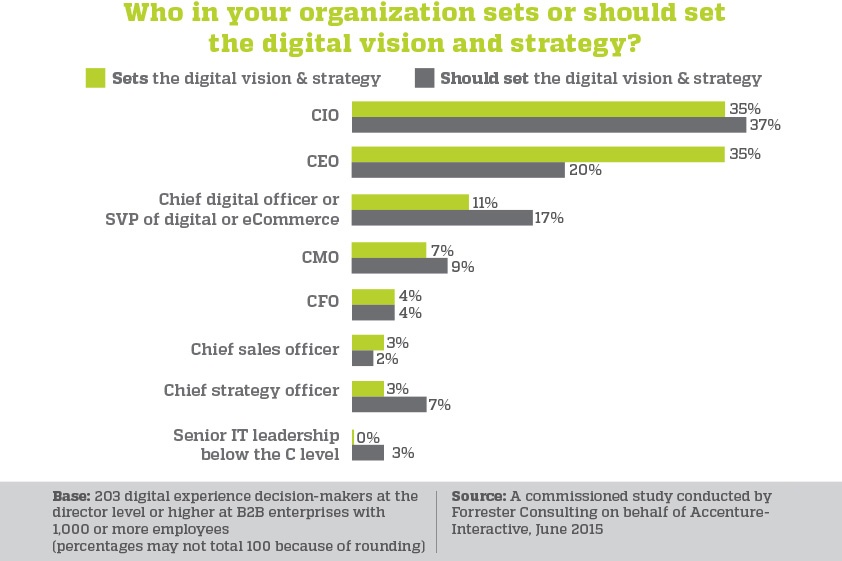 In order to capture and sustain the attention of millennial buyers, you'll need to involve the C-suite to align all parts of your business to provide value to the customer – whether R&D, HR and company culture, or sales.
An exceptional customer experience will reflect this alignment.
In order to capture and sustain the attention of millennial buyers, you'll need to involve the C-suite to align all parts of your business to provide value to the customer – whether R&D, HR and company culture, or sales.
An exceptional customer experience will reflect this alignment.











